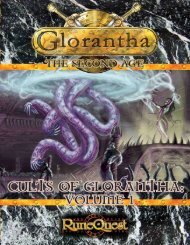Untitled - Index of - Free
Untitled - Index of - Free
Untitled - Index of - Free
You also want an ePaper? Increase the reach of your titles
YUMPU automatically turns print PDFs into web optimized ePapers that Google loves.
descriptions as, 'I swing my sword at the guy.' All that this<br />
will kill is the mood. This is Theatrix, so you're going to<br />
need to use a lot more dramatic license than that. In<br />
Theatrix you describe your attacks with descriptions more<br />
like 'I wait for his swing, parry it over my head with my<br />
shield, and take a full swipe with my mace, aiming for his<br />
legs in order to sweep them out from under him.' Yeah, the<br />
second description is a little longer, but we feel it's well<br />
worth the wait. Just remember to have fun and you'll do<br />
all right Not only that, but if you're not having fun, the<br />
Director is instructed to lean on you hard. No acting, no<br />
action, no Successes.<br />
FIGHTING STYLES<br />
While it may be more fun to embellish in combats,<br />
it's sometimes hard to do. Especially for those <strong>of</strong> us who<br />
lack basic training in modern and historic weapon's<br />
tactics. So we're going to give you a basic framework, <strong>of</strong>f<br />
<strong>of</strong> which you may roleplay through almost any fight, with<br />
almost any weapons. The basic options in any Theatrix<br />
combat are Plain Fighting, All Out Attack, Full De<br />
fense, and Trickery.<br />
Plain Fighting<br />
With Plain Fighting you're simply doing whatever<br />
is easiest, making attacks <strong>of</strong> opportunity, and keeping up<br />
a good defense. You're not trying anything too fancy, but<br />
you're still attempting to win. You're not going to take any<br />
chances, but you're not going to let any get by you either.<br />
The disadvantage <strong>of</strong> Plain Fighting is that you can<br />
sometimes be caught <strong>of</strong>f balance by a more daring and<br />
ferocious attack (see All Out Attack). You may describe<br />
Plain Fighting as ...<br />
¢ Fencing, Taking a rest. Contending, Keeping<br />
All Out Attack<br />
the pace, Keeping her at bay, Taking her<br />
measure, or Sizing her up.<br />
In an All Out Attack you throw caution to the wind<br />
and go for the most damage you can possibly inflict. The<br />
problem is that you're basically defenseless, and if your<br />
opponent is much better than you, probably in a lot <strong>of</strong><br />
trouble. This is <strong>of</strong>ten the kind <strong>of</strong> action you commit to, only<br />
to realize it was a mistake shortly thereafter. However, All<br />
Out Attacks make excellent finishing moves (putting a<br />
fading opponent out <strong>of</strong> the battle before she has a chance<br />
to recover or get lucky), and an unexpected onslaught <strong>of</strong><br />
this ferocity can occasionally have great effect if used<br />
properly. An All Out Attack may also briefly cover a lack<br />
<strong>of</strong> skill with a flurry <strong>of</strong> blows, but this is a dangerous bluff<br />
against anyone who clearly outmatches you. You may<br />
describe All Out Attacks as ..<br />
¢ Going for It, Raining blows, Going all out, Full<br />
Full Defense<br />
committal, Berserk, or Frenzy.<br />
When choosing Full Defense, an Actor is concen<br />
trating solely on keeping her character alive and unin<br />
jured. With this type <strong>of</strong> fighting the character will be very<br />
hard to hurt, but then again, she won't be accomplishing<br />
much else. Full Defense may sometimes be the only way<br />
to keep yourself intact against a superior opponent. The<br />
problem with a Full Defense is that it's very hard to get the<br />
measure <strong>of</strong> your opponent using such tactics. With Plain<br />
Fighting, or an All Out Attack, you have a much better<br />
opportunity to judge your opponents style, pacmg,<br />
strengths, and deficits. As they say, nothing ventured,<br />
nothing gained. You may describe a Full Defense as ...<br />
¢ Giving ground, All out defense, Parry, Block,<br />
Trickery<br />
or Dodge.<br />
When engaging in Trickery, you're hoping to some<br />
how unbalance your opponent into either giving you an<br />
opening for an attack, or allowing you to escape. Trickery<br />
is the use <strong>of</strong> the unorthodox, such as sleight <strong>of</strong> hand, sand<br />
in the face, baiting an attack with a false opening, etc.<br />
Trickery is always dangerous, because if it fails, you'll<br />
<strong>of</strong>ten find that you're the one who has been unbalanced.<br />
You may describe Trickery as ...<br />
¢ Feint, Hand switch, Throw sand in the eyes,<br />
DAMAGE<br />
Sleight <strong>of</strong> hand, Hidden weapon, Bluffing, or<br />
Playing Dead.<br />
One <strong>of</strong> the most difficult subjects to tackle in a free<br />
form style game like Theatrix is how to handle damage.<br />
How do you tell when someone has been incapacitated,<br />
knocked unconscious, or killed? How long do the effects<br />
<strong>of</strong> damage last? What kinds <strong>of</strong> weapons do what kinds <strong>of</strong><br />
damage? Our solution is just to tell your story. Damage is<br />
the premier Plot Device. Of course we're going to give you<br />
a framework to build your descriptions <strong>of</strong> damage around,<br />
which is why we're now introducing the concept <strong>of</strong> Wound<br />
Levels.<br />
Theatrlx - The Core Rules 91



